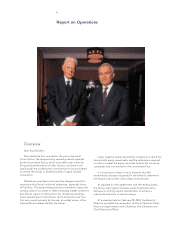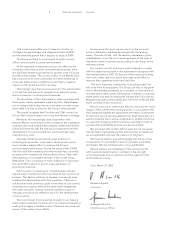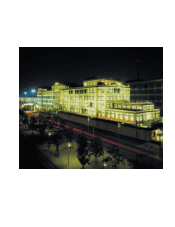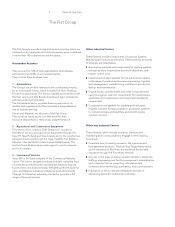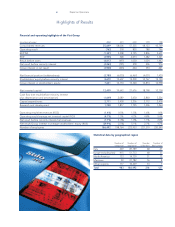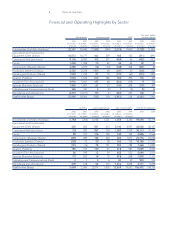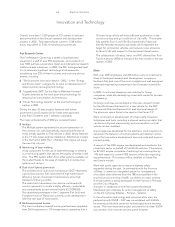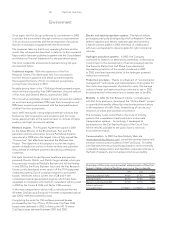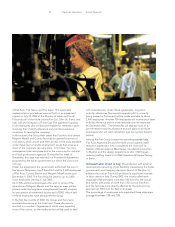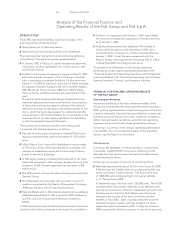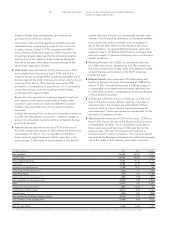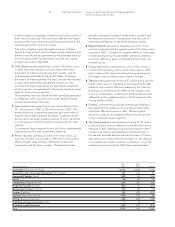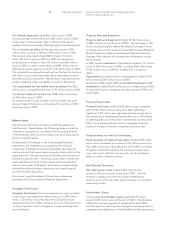Chrysler 2002 Annual Report Download - page 16
Download and view the complete annual report
Please find page 16 of the 2002 Chrysler annual report below. You can navigate through the pages in the report by either clicking on the pages listed below, or by using the keyword search tool below to find specific information within the annual report.
14 Report on Operations
Overall, more than 13,200 people at 127 centers in Italy and
abroad worked on the Group’s research and development
projects in 2002. Total expenditures came to 1,748 million
euros, equivalent to 3.5% of manufacturing revenues.
Fiat Research Center
The Fiat Research Center has a wealth of sophisticated
equipment, a staff of over 950 employees, and a network of
over 1000 partners (universities, Italian and international research
institutions and industries). In 2002, the FRC distinguished itself
for its extremely significant technological achievements,
transferring over 250 of them to clients and receiving various
awards, including:
❚“The Economist Innovation Award – 2002,” in the “Energy
and Environment” category for its work on development of
diesel common rail engine technology;
❚“Legambiente 2002” for the Hybrid Methane-Powered
Engine, awarded as the most promising technology for
reducing fuel consumption and emissions;
❚“Ferrari Technology Awards” as the best technological
partner in 2002.
During the year, 43 new projects financed with Italian
government and European Union funds were approved.
It also filed 72 patents and 7 software copyrights.
The major achievements of 2002 are reviewed below:
❚Multijet
The Multijet system represents the second generation of
the common rail, with dramatically improved performance.
It was initially applied on Fiat vehicles in 2002, being featured
in the 1.9 liter diesel engines installed on Alfa Romeo models.
In the first half of 2003, the 1.3 Multijet 16V engine will equip
the new Fiat city cars.
❚Monitoring of laser welding
A key component for the use of laser technology in welding
is a monitoring system that reports the quality of welds in real
time. The FRC system differs from other systems available on
the market thanks to the ease of installing it on production
systems and using it.
❚Dual clutch hybrid powertrain
The architecture of dual clutch transmission (DCT) represents
a promising solution that combines the high transmission
efficiency typical of automatic transmissions and a high
standard of driving comfort.
The dual clutch transmission can also be combined with
amotor generator to create a highly efficient, comfortable,
and competitively priced minimal hybrid (ECODRIVER).
Two operating prototypes in the C segment (Fiat Stilo) and
Esegment (Lancia Thesis) are currently under development
with this new type of transmission.
❚Methane-powered busses
The Iveco methane-powered bus engine has been upgraded
from 260 horsepower to 310 horsepower to guarantee that a
18 meter long vehicle will have sufficient acceleration in the
continuous stop-and-go conditions of city traffic. This engine
fully satisfies Euro 4 and EEV (Environmentally Enhanced
friendly Vehicles) emissions standards, which represent the
target for commercial vehicles, and reduces noise emissions
by about 2 dB with respect to the equivalent diesel version.
The collaboration of Irisbus, Iveco, and FRC allowed the Turin
Transit Authority (ATM) to introduce the first models in the last
quarter of 2002.
Elasis
With over 1000 employees and 260 million euros in investments,
Elasis is the largest research and development company in
Southern Italy and one of the most complete and well-equipped
advanced engineering companies in the European automobile
sector.
In 2002, it continued designing new vehicles for Group
companies, while also developing a new skills center for process
engineering.
Its design work was concentrated on the new compact model
for the Alfa Romeo Business Unit, a new vehicle for the FIAT
Commercial Vehicles Business Unit, and structural design of
the aluminum space frame to be used on the Ferrari 137.
Work continued on development of virtual reality immersion
techniques and tools, including a physical seating simulator that
can be reconfigured electronically and around which a virtual
vehicle can be visualized.
A prototype was developed for the electronic control systems to
reproduce the behavior of control systems and develop control
logics that can reduce development time and costs and improve
product quality.
A version of the FIRE engine was developed and created in the
powertrain sector on behalf of Fiat-GM Powertrain. This version,
an 8V, EVO engine is capable of reducing fuel consumption by
11% with respect to current FIRE versions while also improving
its performance. This version will be installed on future Fiat
and Lancia models.
Work with public agencies to improve highway safety
expanded during the year. In partnership with the Province
of Milan, it created an integrated system for management
of accident data obtained from the 188 municipalities in the
province and monitoring of traffic conditions on major arteries.
A similar system is being developed for the Province of Perugia
and the City of Naples.
A project in collaboration with the Società Autostrade
Meridionali got underway for active management of safety
on the A3 motorway (Naples – Pompei – Salerno).
In the information technology and communication area, the
partnership with ISVOR – FIAT was consolidated, with ELASIS
functioning as the skills center for technological and e-learning
issues. The most important project executed for its client ISVOR
was creation of an Internet services portal (e-dotto).
Innovation and Technology


